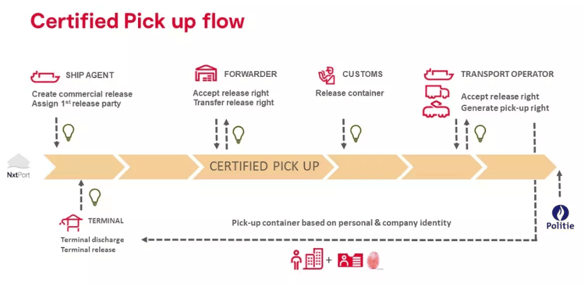In our previous post, we talked about the history of the MASP-C journey toward electronic customs and the delays along the way. However, it is not only customs that is modernising and automating; the ports also need to play their part.
In this blog post, we will put the spotlight on the new ‘Certified Pick up platform’ of the port of Antwerp-Bruges, which will need to be used as of January 15, 2024 for the entire import container process.
What is the Certified Pick up platform?
NxtPort together with the port community and port of Antwerp-Bruges has built a digital platform where different supply chain actors can collaborate for container releases in the port itself. The platform collects container information from the various parties involved to streamline the import process and secure the effective pick up, as this will no longer be possible via PIN codes, only via identity of the truck driver.
Why is it being introduced?
Digitalisation is key for a port if it wants to be competitive in the market. Goods always need to flow faster and more efficiently through the ports in order to be delivered as quickly as possible to the end destination. This requires automation and digitalisation.
The Certified Pick up platform will also ensure more transparency on the status of containers. This will lead to more operational and administrative efficiency for the supply chain actors and a reduction in turnaround time of import containers at the port.
Also, safety is one of the main reasons why the platform is introduced and will be mandatory as of 15 January 2024. Currently, the pick-up of containers is organised based on PIN codes that are created by the shipping company and shared with the transport operators. This leaves quite some time between creation of the code and the real pick-up, which is time that can be abused by people with bad intentions. To avoid this in the future, a container pick-up will only be possible based on the identity of the truck driver and the system will track the parties who have collected the containers.
For whom is the Certified Pick up platform intended?
The following 4 roles are defined within the platform and will need to use the platform:
- Shipping agent
- Terminal operator
- Release party (which can be the freight forwarder, consignee, or cargo owner)
- Transport operator
How should it be used?
As mentioned above, the Certified Pick up platform collects container information. Based on that information, the platform will generate a digital release right, and a digital pick-up right, which allows the container to be picked up.
The release right is generated by the shipping company based on commercial release information. This right can be passed from one company to another.
The digital pick-up right is not created until the final transport operator of the container is known. Thus, the system minimises the time between the creation of the right and the collection of the container.

Shipping agents:
The shipping agent sends container release information to the platform, which is based on the commercial release, and transfers the release right by assigning the first release party. This is the party responsible for handling import formalities to collect the container at the terminal.
Terminal operators:
The terminal supplies status information of the container to the Certified Pick up platform. It informs the platform about the discharge of the container (is the container unloaded at the terminal?) and the terminal release (is the container physically available at the terminal and are they okay with the container leaving the terminal?). At the end of the process, they also validate the pick-up right.
Release party:
The release right is transferred by the shipping agent to the first release party, which could be either the freight forwarder, consignee, or cargo owner. They can either convert it into a pick-up right if they will collect the container, or they can transfer it to the transport operator.
Transport operators:
The transport operator can pick up the container if the following two conditions are fulfilled:
- They received the release right from the release party, which they can convert into a pick-up right.
- The container terminal forwarded a terminal release.
When this is true, the transport operator can assign a driver (via the Alfapass number) to pick up the container. In case inland navigation or railway companies are used, the packing lists can be sent to the terminal.
Important to note is that all these actions can either be done via a web portal (except for the terminal operators) or via API connections, where the involved parties can link their ERP systems directly to the Certified Pick up platform.
We at Portorium Solutions encourage the ideas and initiatives for further automating customs-related processes, as this is the future. We only gave a short overview of the new platform, however we would be happy to discuss this topic or any related topic further. Just reach out!


Leave a Comment